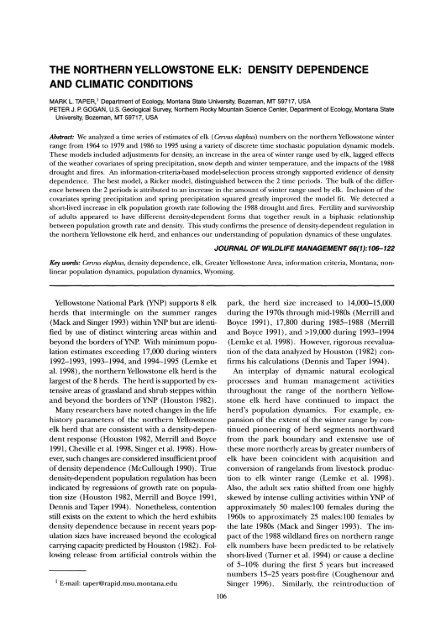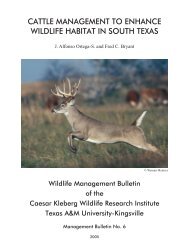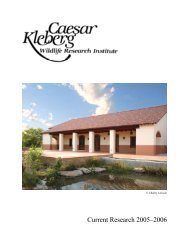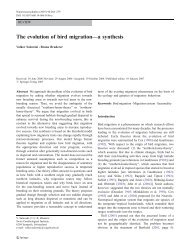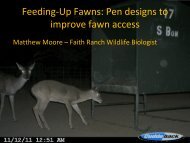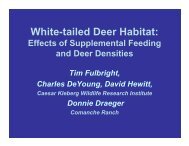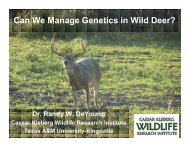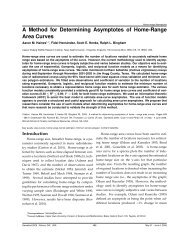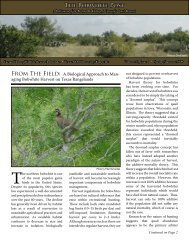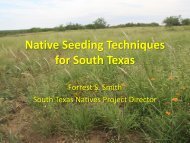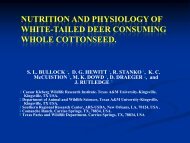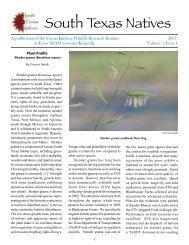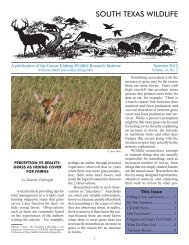The Northern Yellowstone Elk: Density Dependence and Climatic ...
The Northern Yellowstone Elk: Density Dependence and Climatic ...
The Northern Yellowstone Elk: Density Dependence and Climatic ...
You also want an ePaper? Increase the reach of your titles
YUMPU automatically turns print PDFs into web optimized ePapers that Google loves.
THE NORTHERN YELLOWSTONELK: DENSITY DEPENDENCEAND CLIMATICONDITIONSMARK L. TAPER,1 Department of Ecology, Montana State University, Bozeman, MT 59717, USAPETER J. P. GOGAN, U.S. Geological Survey, <strong>Northern</strong> Rocky Mountain Science Center, Department of Ecology, Montana StateUniversity, Bozeman, MT 59717, USAAbstract: We analyzed a time series of estimates of elk (Cervus elaphus) numbers on the northern <strong>Yellowstone</strong> winterrange from 1964 to 1979 <strong>and</strong> 1986 to 1995 using a variety of discrete time stochastic population dynamic models.<strong>The</strong>se models included adjustments for density, an increase in the area of winter range used by elk, lagged effectsof the weather covariates of spring precipitation, snow depth <strong>and</strong> winter temperature, <strong>and</strong> the impacts of the 1988drought <strong>and</strong> fires. An information-criteria-based model-selection process strongly supported evidence of densitydependence. <strong>The</strong> best model, a Ricker model, distinguished between the 2 time periods. <strong>The</strong> bulk of the differencebetween the 2 periods is attributed to an increase in the amount of winter range used by elk. Inclusion of thecovariates spring precipitation <strong>and</strong> spring precipitation squared greatly improved the model fit. We detected ashort-lived increase in elk population growth rate following the 1988 drought <strong>and</strong> fires. Fertility <strong>and</strong> survivorshipof adults appeared to have different density-dependent forms that together result in a biphasic relationshipbetween population growth rate <strong>and</strong> density. This study confirms the presence of density-dependent regulation inthe northern <strong>Yellowstone</strong> elk herd, <strong>and</strong> enhances our underst<strong>and</strong>ing of population dynamics of these ungulates.JOURNAL OF WILDLIFE MANAGEMENT 66(1):106-122Key words: Cervus elaphus, density dependence, elk, Greater <strong>Yellowstone</strong> Area, information criteria, Montana, nonlinearpopulation dynamics, population dynamics, Wyoming.<strong>Yellowstone</strong> National Park (YNP) supports 8 elkherds that intermingle on the summer ranges(Mack <strong>and</strong> Singer 1993) within YNP but are identifiedby use of distinct wintering areas within <strong>and</strong>beyond the borders of YNP. With minimum populationestimates exceeding 17,000 during winters1992-1993, 1993-1994, <strong>and</strong> 1994-1995 (Lemke etal. 1998), the northern <strong>Yellowstone</strong> elk herd is thelargest of the 8 herds. <strong>The</strong> herd is supported by ex-tensive areas of grassl<strong>and</strong> <strong>and</strong> shrub steppes within<strong>and</strong> beyond the borders of YNP (Houston 1982).Many researchers have noted changes in the lifehistory parameters of the northern <strong>Yellowstone</strong>elk herd that are consistent with a density-dependentresponse (Houston 1982, Merrill <strong>and</strong> Boyce1991, Cheville et al. 1998, Singer et al. 1998). However,such changes are considered insufficient proofof density dependence (McCullough 1990). Truedensity-dependent population regulation has beenindicated by regressions of growth rate on populationsize (Houston 1982, Merrill <strong>and</strong> Boyce 1991,Dennis <strong>and</strong> Taper 1994). Nonetheless, contentionstill exists on the extent to which the herd exhibitsdensity dependence because in recent years populationsizes have increased beyond the ecologicalcarrying capacity predicted by Houston (1982). Followingrelease from artificial controls within the1 E-mail: taper@rapid.msu.montana.edupark, the herd size increased to 14,000-15,000during the 1970s through mid-1980s (Merrill <strong>and</strong>Boyce 1991), 17,800 during 1985-1988 (Merrill<strong>and</strong> Boyce 1991), <strong>and</strong> >19,000 during 1993-1994(Lemke et al. 1998). However, rigorous reevaluationof the data analyzed by Houston (1982) confirmshis calculations (Dennis <strong>and</strong> Taper 1994).An interplay of dynamic natural ecologicalprocesses <strong>and</strong> human management activitiesthroughout the range of the northern <strong>Yellowstone</strong>elk herd have continued to impact theherd's population dynamics. For example, expansionof the extent of the winter range by con-tinued pioneering of herd segments northwardfrom the park boundary <strong>and</strong> extensive use ofthese more northerly areas by greater numbers ofelk have been coincident with acquisition <strong>and</strong>conversion of rangel<strong>and</strong>s from livestock productionto elk winter range (Lemke et al. 1998).Also, the adult sex ratio shifted from one highlyskewed by intense culling activities within YNP ofapproximately 50 males:100 females during the1960s to approximately 25 males:100 females bythe late 1980s (Mack <strong>and</strong> Singer 1993). <strong>The</strong> im-pact of the 1988 wildl<strong>and</strong> fires on northern rangeelk numbers have been predicted to be relativelyshort-lived (Turner et al. 1994) or cause a declineof 5-10% during the first 5 years but increasednumbers 15-25 years post-fire (Coughenour <strong>and</strong>Singer 1996). Similarly, the reintroduction of106


